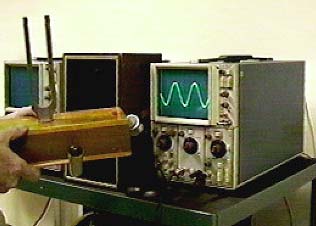Tuning Fork Modes
| The tuning fork has a very stable pitch and has been used as a pitch standard since the Baroque period. |
 |
The "clang" mode has a frequency which depends upon the details of construction, but is usuallly somewhat above 6 times the frequency of the fundamental. This is close to the first overtone of the clamped bar. The clang tone dies away rapidly. |
The two sides or "tines" of the tuning fork vibrate at the same frequency but move in opposite directions at any given time. The two sound waves generated will show the phenomenon of sound interference.
| Illustration with oscilloscope |
Percussion instruments
Musical instruments
| HyperPhysics***** Sound | R Nave |
